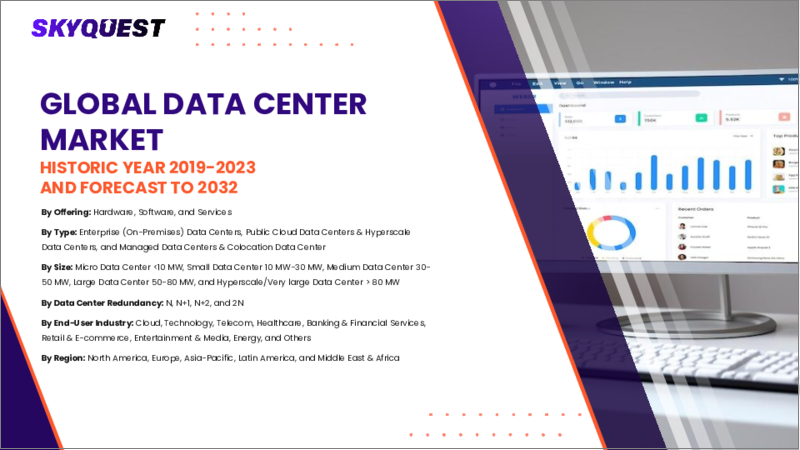|
|
市場調査レポート
商品コード
1687617
データセンター市場規模、シェア、成長分析:コンポーネント別、データセンタータイプ別、企業規模別、ティアレベル別、データセンターサイズ別、業界別、地域別 - 産業予測 2025~2032年Data Center Market Size, Share, and Growth Analysis, By Component (Hardware, Services), By Data Center Type (Colocation, Hyperscale), By Enterprise Size, By Tier Level, By Data Center Size, By Industry, By Region - Industry Forecast 2025-2032 |
||||||
|
|||||||
| データセンター市場規模、シェア、成長分析:コンポーネント別、データセンタータイプ別、企業規模別、ティアレベル別、データセンターサイズ別、業界別、地域別 - 産業予測 2025~2032年 |
|
出版日: 2025年03月19日
発行: SkyQuest
ページ情報: 英文 157 Pages
納期: 3~5営業日
|
全表示
- 概要
- 目次
データセンター市場規模は2023年に3,645億米ドルとなり、2024年の3,954億8,000万米ドルから2032年には7,595億7,000万米ドルに成長し、予測期間中(2025-2032年)のCAGRは8.5%で成長する見通しです。
5Gネットワークの急増により、ユーザーはより高速なダウンロード、シームレスなストリーミング、オンラインサービスへのアクセス強化を求めるようになり、データセンターインフラに対する需要はかつてないほど高まっています。この技術的進歩により、データトラフィックの増加に対応するための堅牢なデータセンターが必要となり、特にエッジコンピューティングソリューションに移行するクラウドプロバイダーにとって重要です。マイクロデータセンターは、産業オートメーションや自律走行車など、時間に敏感なアプリケーションの待ち時間を短縮するなどの重要な利点を提供するため、特に中小企業や大企業の間で人気を集めています。さらに、ポータブルでコンパクト、モジュール化されたデータセンターの人気が高まっていることも、マイクロデータセンターの魅力を高めています。これらの施設は簡単に展開でき、特定のニーズに適応できるため、進化する情勢において重要な役割を担っています。
目次
イントロダクション
- 調査の目的
- 調査範囲
- 定義
調査手法
- 情報調達
- 二次と一次データの方法
- 市場規模予測
- 市場の前提条件と制限
エグゼクティブサマリー
- 世界市場の見通し
- 供給と需要の動向分析
- セグメント別機会分析
市場力学と見通し
- 市場概要
- 市場規模
- 市場力学
- 促進要因と機会
- 抑制要因と課題
- ポーターの分析
主な市場の考察
- 重要成功要因
- 競合の程度
- 主な投資機会
- 市場エコシステム
- 市場の魅力指数(2024年)
- PESTEL分析
- マクロ経済指標
- バリューチェーン分析
- 価格分析
- 技術の進歩
- ケーススタディ
データセンター市場規模:コンポーネント別& CAGR(2025-2032)
- 市場概要
- ハードウェア
- 電力システム
- 冷却システム
- サーバー
- ネットワークデバイス
- その他
- ラック
- DCIM(データセンターインフラストラクチャ管理)ソフトウェア
- オンプレミス
- クラウド
- サービス
データセンター市場規模:データセンタータイプ別& CAGR(2025-2032)
- 市場概要
- コロケーション
- ハイパースケール
- エッジ
- その他
- 管理
- モジュラー
データセンター市場規模:企業規模別& CAGR(2025-2032)
- 市場概要
- 中小企業
- 大企業
データセンター市場規模:ティアレベル別& CAGR(2025-2032)
- 市場概要
- ティア1とティア2
- ティア3
- ティア4
データセンター市場規模:データセンターサイズ別& CAGR(2025-2032)
- 市場概要
- 小
- 中
- 大
データセンター市場規模:業界別& CAGR(2025-2032)
- 市場概要
- BFSI
- ITおよび通信
- ヘルスケア
- 政府
- 製造業
- 小売・eコマース
- その他
- メディアとエンターテイメント
データセンター市場規模:地域別& CAGR(2025-2032)
- 北米
- 米国
- カナダ
- 欧州
- ドイツ
- スペイン
- フランス
- 英国
- イタリア
- その他欧州地域
- アジア太平洋地域
- 中国
- インド
- 日本
- 韓国
- その他アジア太平洋地域
- ラテンアメリカ
- ブラジル
- その他ラテンアメリカ地域
- 中東・アフリカ
- GCC諸国
- 南アフリカ
- その他中東・アフリカ
競合情報
- 上位5社の比較
- 主要企業の市場ポジショニング(2024年)
- 主な市場企業が採用した戦略
- 最近の市場動向
- 企業の市場シェア分析(2024年)
- 主要企業の企業プロファイル
- 企業の詳細
- 製品ポートフォリオ分析
- 企業のセグメント別シェア分析
- 収益の前年比比較(2022-2024)
主要企業プロファイル
- Amazon Web Services(AWS)(USA)
- Microsoft Azure(USA)
- Google Cloud Platform(GCP)(USA)
- Equinix(USA)
- Digital Realty(USA)
- NTT Global Data Centers(Japan)
- Alibaba Cloud(China)
- Oracle Cloud(USA)
- IBM Cloud(USA)
- Tencent Cloud(China)
- OVHcloud(France)
- Iron Mountain Data Centers(USA)
- Cyxtera Technologies(USA)
- CoreSite(USA)
- QTS Data Centers(USA)
- CloudHQ(USA)
- KDDI(Japan)
- Fujitsu(Japan)
- H5 Data Centers(USA)
結論と提言
Data Center Market size was valued at USD 364.5 billion in 2023 and is poised to grow from USD 395.48 billion in 2024 to USD 759.57 billion by 2032, growing at a CAGR of 8.5% during the forecast period (2025-2032).
The surge in 5G networks is driving unprecedented demand for data center infrastructure as users seek faster downloads, seamless streaming, and enhanced access to online services. This technological advancement necessitates robust data centers to accommodate the resulting increase in data traffic, particularly for cloud providers moving towards edge computing solutions. Micro data centers are gaining traction, especially among SMEs and large enterprises, as they offer crucial advantages like reduced latency for time-sensitive applications in industrial automation and autonomous vehicles. Additionally, the rising popularity of portable, compact, modularized data centers enhances the appeal of micro data centers. These facilities are easily deployable and adaptable to specific needs, positioning them as a key player in the evolving data center landscape.
Top-down and bottom-up approaches were used to estimate and validate the size of the Data Center market and to estimate the size of various other dependent submarkets. The research methodology used to estimate the market size includes the following details: The key players in the market were identified through secondary research, and their market shares in the respective regions were determined through primary and secondary research. This entire procedure includes the study of the annual and financial reports of the top market players and extensive interviews for key insights from industry leaders such as CEOs, VPs, directors, and marketing executives. All percentage shares split, and breakdowns were determined using secondary sources and verified through Primary sources. All possible parameters that affect the markets covered in this research study have been accounted for, viewed in extensive detail, verified through primary research, and analyzed to get the final quantitative and qualitative data.
Data Center Market Segments Analysis
Global Data Center Market is segmented by Component, Data Center Type, Enterprise Size, Tier Level, Data Center Size, Industry and region. Based on Component, the market is segmented into Hardware, DCIM (Data Center Infrastructure Management) Software and Services. Based on Data Center Type, the market is segmented into Colocation, Hyperscale, Edge and Others. Based on Enterprise Size, the market is segmented into SMEs and Large Enterprises. Based on Tier Level, the market is segmented into Tier 1 and Tier 2, Tier 3 and Tier 4. Based on Data Center Size, the market is segmented into Small, Medium and Large. Based on Industry, the market is segmented into BFSI, IT & Telecom, Healthcare, Government, Manufacturing, Retail & E-commerce and Others. Based on region, the market is segmented into North America, Europe, Asia Pacific, Latin America and Middle East & Africa.
Driver of the Data Center Market
The Data Center market is primarily driven by the surging need for data storage and processing capabilities, fueled by the rise of cloud computing, big data analytics, and ongoing digital transformation initiatives. As businesses and projects continuously generate and utilize vast quantities of data, there is an escalating demand for robust data processing infrastructure. This necessitates the establishment of multiple data centers to accommodate the central processing capacity required for managing this extensive data flow. Consequently, the imperatives for efficient data management and operational scalability are propelling investments and advancements within the data center sector, marking a significant trend in the current technological landscape.
Restraints in the Data Center Market
The data center market faces several restraints, primarily due to the significant expenses involved in their operation. These costs encompass energy consumption, cooling systems, and ongoing maintenance, which can be particularly burdensome for small businesses and startups operating on constrained budgets. Such financial challenges can hinder their ability to invest in the latest infrastructure or technologies, ultimately limiting their competitiveness in a rapidly evolving digital landscape. Consequently, these high operating costs can serve as a substantial barrier to entry and growth within the data center sector, impacting innovation and development opportunities for smaller enterprises.
Market Trends of the Data Center Market
As of October 2023, the data center market is witnessing a significant shift driven by the rise of edge computing. This paradigm shift is compelling organizations to innovate data center strategies as the demand for faster data processing and reduced latency escalates. By decentralizing data processing and positioning smaller distributed data centers closer to data generation sources, companies can enhance efficiency and enable real-time analytics. This trend not only complements existing traditional data centers but also opens new avenues for infrastructure expansion, promoting scalability and resilience in the face of evolving technological demands. Consequently, edge computing is set to reshape the overall data center landscape.
Table of Contents
Introduction
- Objectives of the Study
- Scope of the Report
- Definitions
Research Methodology
- Information Procurement
- Secondary & Primary Data Methods
- Market Size Estimation
- Market Assumptions & Limitations
Executive Summary
- Global Market Outlook
- Supply & Demand Trend Analysis
- Segmental Opportunity Analysis
Market Dynamics & Outlook
- Market Overview
- Market Size
- Market Dynamics
- Drivers & Opportunities
- Restraints & Challenges
- Porters Analysis
- Competitive rivalry
- Threat of substitute
- Bargaining power of buyers
- Threat of new entrants
- Bargaining power of suppliers
Key Market Insights
- Key Success Factors
- Degree of Competition
- Top Investment Pockets
- Market Ecosystem
- Market Attractiveness Index, 2024
- PESTEL Analysis
- Macro-Economic Indicators
- Value Chain Analysis
- Pricing Analysis
- Technological Advancement
- Case Studies
Global Data Center Market Size by Component & CAGR (2025-2032)
- Market Overview
- Hardware
- Power Systems
- Cooling Systems
- Servers
- Networking Devices
- Others
- Racks
- DCIM (Data Center Infrastructure Management) Software
- On-premises
- Cloud
- Services
Global Data Center Market Size by Data Center Type & CAGR (2025-2032)
- Market Overview
- Colocation
- Hyperscale
- Edge
- Others
- Managed
- Modular
Global Data Center Market Size by Enterprise Size & CAGR (2025-2032)
- Market Overview
- SMEs
- Large Enterprises
Global Data Center Market Size by Tier Level & CAGR (2025-2032)
- Market Overview
- Tier 1 and Tier 2
- Tier 3
- Tier 4
Global Data Center Market Size by Data Center Size & CAGR (2025-2032)
- Market Overview
- Small
- Medium
- Large
Global Data Center Market Size by Industry & CAGR (2025-2032)
- Market Overview
- BFSI
- IT & Telecom
- Healthcare
- Government
- Manufacturing
- Retail & E-commerce
- Others
- Media & Entertainment
Global Data Center Market Size & CAGR (2025-2032)
- North America (Component, Data Center Type, Enterprise Size, Tier Level, Data Center Size, Industry)
- US
- Canada
- Europe (Component, Data Center Type, Enterprise Size, Tier Level, Data Center Size, Industry)
- Germany
- Spain
- France
- UK
- Italy
- Rest of Europe
- Asia Pacific (Component, Data Center Type, Enterprise Size, Tier Level, Data Center Size, Industry)
- China
- India
- Japan
- South Korea
- Rest of Asia-Pacific
- Latin America (Component, Data Center Type, Enterprise Size, Tier Level, Data Center Size, Industry)
- Brazil
- Rest of Latin America
- Middle East & Africa (Component, Data Center Type, Enterprise Size, Tier Level, Data Center Size, Industry)
- GCC Countries
- South Africa
- Rest of Middle East & Africa
Competitive Intelligence
- Top 5 Player Comparison
- Market Positioning of Key Players, 2024
- Strategies Adopted by Key Market Players
- Recent Developments in the Market
- Company Market Share Analysis, 2024
- Company Profiles of All Key Players
- Company Details
- Product Portfolio Analysis
- Company's Segmental Share Analysis
- Revenue Y-O-Y Comparison (2022-2024)
Key Company Profiles
- Amazon Web Services (AWS) (USA)
- Company Overview
- Business Segment Overview
- Financial Updates
- Key Developments
- Microsoft Azure (USA)
- Company Overview
- Business Segment Overview
- Financial Updates
- Key Developments
- Google Cloud Platform (GCP) (USA)
- Company Overview
- Business Segment Overview
- Financial Updates
- Key Developments
- Equinix (USA)
- Company Overview
- Business Segment Overview
- Financial Updates
- Key Developments
- Digital Realty (USA)
- Company Overview
- Business Segment Overview
- Financial Updates
- Key Developments
- NTT Global Data Centers (Japan)
- Company Overview
- Business Segment Overview
- Financial Updates
- Key Developments
- Alibaba Cloud (China)
- Company Overview
- Business Segment Overview
- Financial Updates
- Key Developments
- Oracle Cloud (USA)
- Company Overview
- Business Segment Overview
- Financial Updates
- Key Developments
- IBM Cloud (USA)
- Company Overview
- Business Segment Overview
- Financial Updates
- Key Developments
- Tencent Cloud (China)
- Company Overview
- Business Segment Overview
- Financial Updates
- Key Developments
- OVHcloud (France)
- Company Overview
- Business Segment Overview
- Financial Updates
- Key Developments
- Iron Mountain Data Centers (USA)
- Company Overview
- Business Segment Overview
- Financial Updates
- Key Developments
- Cyxtera Technologies (USA)
- Company Overview
- Business Segment Overview
- Financial Updates
- Key Developments
- CoreSite (USA)
- Company Overview
- Business Segment Overview
- Financial Updates
- Key Developments
- QTS Data Centers (USA)
- Company Overview
- Business Segment Overview
- Financial Updates
- Key Developments
- CloudHQ (USA)
- Company Overview
- Business Segment Overview
- Financial Updates
- Key Developments
- KDDI (Japan)
- Company Overview
- Business Segment Overview
- Financial Updates
- Key Developments
- Fujitsu (Japan)
- Company Overview
- Business Segment Overview
- Financial Updates
- Key Developments
- H5 Data Centers (USA)
- Company Overview
- Business Segment Overview
- Financial Updates
- Key Developments





